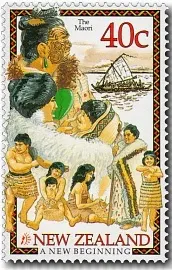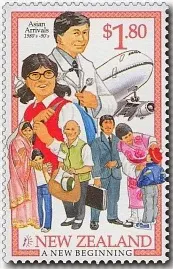Immigration to a New Land.
The second issue in the Millennium series was about immigration to New Zealand by people wanting to make a new start in a new country.
New Zealand was the last major land area outside the polar regions to be occupied by humans. This occupation began a thousand years ago and involved, perhaps, a few thousand migrants who braved the south-west Pacific Ocean to get to New Zealand from Central Polynesia.
European settlement began seriously in New Zealand around 1815, and by 1881, the non-Maori population had reached half a million. By the middle of that same decade, people born in New Zealand became a majority of the non-Maori population.
By the time the Immigration Act 1987 was passed, less than half of New Zealand’s new permanent migrants were from Europe or North America. The new Act favoured those with skills New Zealand needed, as a result, there was a rapid increase in the numbers of migrants coming from Hong Kong, Taiwan and Malaysia.
In the 1990s, a point system opened up immigration even further and by 1995 Taiwan had replaced Britain as the largest country of origin.
40c - The Maori /The First Settlers. $1.00 - Fortune Seekers (1800-1920).
80c - British / European Settlers (1840-1914).
$1.20 - Post War British / European Migrants (1945-1970).
$1.50 - Pacific Islanders (1960-).
$1.80 - Asian Arrivals (1980-).
The Stamps and their Subjects.
40c - The Maori /The First Settlers.
In the first Millennium Issue we learnt about the Maori explorers Maui and Kupe. When men such as these returned telling of a large bountiful land it was natural that many would wish to follow them. This began the first wave of immigrants to arrive in New Zealand when they trvelled from Hawaiki, around 1,000 years ago. The myth of a great fleet of canoes is just that, a myth. Immigrants arrived over a long period, different canoes, from different places, but they all had one thing in common, they were seeking a new and better home.
At first there was contact with their homelands but by the time the Europeans arrived, Maori had lost all contact with other Pacific Islanders. By the eighteenth century, Maori lived throughout New Zealand in communities ranging from a single family to many hundreds of people.
For other stamps with Maori themes see our index New Zealand Maori.
80c - British / European Settlers (1840-1914).
Between 1840 and 1850, some 15,000 immigrants were brought to New Zealand from Britain to found and develop various settlements. Companies were established to purchase land and bring people to populate these new communities. Some were successful and grew from strength to strength but others struggled a few years, then died, with people moving on to more promising locations. By 1880, some 100,000 immigrants called New Zealand home, including significant numbers of Scandinavians and Germans.
$1.00 - Fortune Seekers (1800-1920).
The discovery of gold in Otago prompted a massive influx of more than 200,000 immigrants during the 1860s, including Chinese gold prospectors who were imported to work in the fields. Immigrant’s from the Dalmatian coast of Croatia came to work the kauri gumfields of Northland and the Coromandel Peninsula.
The one disadvantage with this new wave of immigration was that it was mainly males. This had the effect of creating out of balance populations in some areas with men far out numbering females.
$1.20 - Post War British / European Migrants (1945-1970).
During World War II, many men never returned, also new industries had developed and expanded. There was a severe shortage of labour which prompted the New Zealand Government to assist immigrants to come to New Zealand from Britain and Europe. Significant numbers of displaced persons and refugees also settled in New Zealand before, during and after World War II.
In some cases the immigrant never settled in their new homeland, we have all heard the term 'winging pomp'. But for most it opened opportunities they would never had got in Europe. These people did so much, contributed so much to this young country.
$1.50 - Pacific Islanders (1960-).
The need for workers to perform ‘unskilled’ work after World War II saw the number of Pacific Island immigrants rise to 47,000 in 1971. By 1996, there were 202,000 people of Pacific Island origin living in New Zealand. While most of these immigrants were good employees, good citizens, continuing with their Christian beliefs and faith, their children were a different story. These children grew up torn between the ties of their parents and the pull of the New Zealand way of life. It would take yet a third generation to overcome these social problems before Pacific Islanders would become embedded in New Zealand society.
$1.80 - Asian Arrivals (1980-).
Since 1987, New Zealand has become home to highly skilled, affluent migrants from North, South and South-East Asia. By 1996, 82,000 people of Chinese origin, 44,000 Indians, 13,000 Koreans and 7,000 Japanese identified themselves as New Zealanders. Together, these groups formed a part of the population that, in just five years, had increased to the point where it was nearly as numerous as the Pacific Island part of the population.
As we have moved into the new century this immigration of Asians has continued. Today you can find people from most countries of Asia. They are active in all sectors and levels of New Zealand Society making an important contribution to the country.
The South Africans 2000-).
Since this stamp issue in 1998, we have seen another group of migrants, The South Africans. By this I mean people coming from the ex-British countries in Southern Africa, not just from South Africa itself. These are mainly people of European decent who have left their home country seeking a better, safer place to bring up their children. Mostly they are skilled, hard working and quickly fit in with New Zealand society. It is amazing now (2014) how often you come across a South African accent.
Miniature Sheets and First Day Covers.
The First Day Cover was a simple design that left lots of room to place the stamps across the top. I like the special cancel too, showing a sailing ship similar to the one shown on the cover.
A special limited edition First Day Cover with a scene of early settlers just landed on the shore ready to begin a new life in a new land. This special cover was also signed by the designer Terry Crilley.
After finding the two First Day Covers, one being a limited edition, I returned to the NZ Post web site for another look. I found the four items above. Unfortunately the image quality is so poor they can't be enlarged.
The top two items are the normal FDC on the left and the usual miniature sheet on the right. The two items on the bottom are the limited edition items, with a miniature being on the left and the FDC seen above on the right. Look closely at the miniature sheet. Just under the words "Limited Edition" you can see a number 1897. This is one of a series individually numbered from one through to 2,000.
Technical information:-
Date of Issue:
| 18 March, 1998. |
|---|---|
Designer:
| Terry Crilley, Blenheim, New Zealand. |
Printer:
| Southern Colour Print, New Zealand. |
Stamp Size:
| 28mm x 44mm; Miniature Sheet Size: 179mm x 95mm. |
Sheet Size:
| 50 stamps per sheet. |
Process:
| Lithography. |
Perforation Gauge:
| 14. |
Paper Type:
| 104 gsm red phosphor coated. |
Some of the images in this post were used with permission from the illustrated catalogue of StampsNZ
You can visit their web site and On-line Catalogue at, http://stampsnz.com/









Comments
Post a Comment
We appreciate your engagement with our content. To ensure a respectful and constructive community, please take note of the following:
- No Spam, Please: We do not tolerate spammy or promotional comments. Any such comments will be promptly removed.
- Moderation in Place: All comments are moderated to maintain a positive and inclusive environment. Please be patient, as it may take a little time for your comment to appear.
- Sign In with Google: To comment, please sign in using your Google account. This helps us maintain the integrity of our community and allows for better interaction.